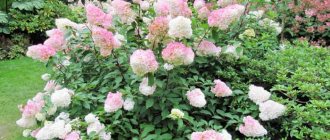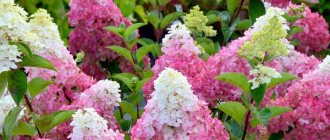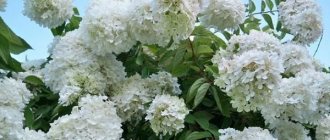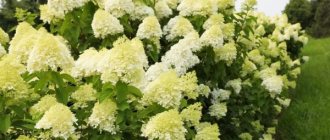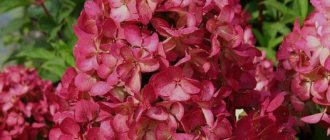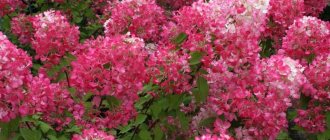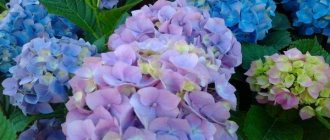Plants » Flowers
0
358
Article rating
Kira Stoletova
Panicle hydrangea Pinky Winky, even in a single copy, can change the garden beyond recognition. The variety, developed just 10 years ago, has become one of the favorites among gardeners. Due to its high decorativeness and excellent frost-resistant characteristics, the plant has become widespread among designers and summer residents as an element of the exterior of their garden plots.
Hydrangea paniculata pinky winky photo and description
History of selection
Hydrangea paniculata “Pinky Winky” is one of the most popular varieties among gardeners. It is part of the large Hydrangeaceae family. In the wild it is found in Japan and China, the Far East, South and North America.
"Pinky Winky" is characterized by its abundant, continuous and long-lasting flowering
The Pinky Winky variety is relatively young. Its breeding is the merit of Belgian breeders. It appeared in 2003. The main distinguishing features are the splendor and size of the inflorescences, which can change colors throughout the season. The Pinky Winky hydrangeas are based on Pink Diamond, another variety of the plant.
Growing a plant on the site
Hydrangea Paniculata Diamant Rouge - description
In the summer season, summer residents are especially acutely concerned with the issue of improving their own territory. In an effort to transform the garden, various garden plants can help, among which hydrangeas of various varieties, especially Pinky Winky, are especially popular.
Important! Many years of experience of gardeners shows that growing a beautiful garden is not a difficult task, but even such seemingly dust-free work has a number of nuances that should be taken into account so that the Pinky Winky hydrangea bushes do not die in the first bad weather.
It is necessary to select a plant seedling for planting. There are many varieties of hydrangeas on the market today. Such a wide choice is due, first of all, to the fact that Pinky Winky hydrangea is quite popular among gardeners.
Moreover, the flowers take root well in the Russian climate, which makes growing them the least problematic for gardeners. As a rule, they do not bring much trouble to gardeners, but even this variety has its own characteristics that should be taken into account when planting.
Preparation and selection of landing site
When planning to plant shrubs on your site, you need to take care of the chemicals and fertilizers that will be required when caring for the plant. After all the shopping, you should start preparing for planting:
- Particular attention should be paid to the amount of light in the place where the Pinky Winky hydrangea will grow. It is worth giving preference to the area that is constantly under good lighting. Paniculata hydrangea is characterized by sufficient light-loving properties. Pinkie responds normally to short periods of shade during the day. The second factor in choosing a location is the wind. This variety does not like chapping, so the area should be protected from the wind as much as possible.
Hydrangea needs a lot of light - The soil must be loose and well-permeable for moisture and air so that the plant has enough nutrition.
- It is necessary to take care of organic fertilizers in advance. Manure should not be added to the soil when planting Pinky. In the process of overheating, it begins to increase the temperature of the earth, which has a bad effect on the condition of the roots and the entire bush. Therefore, it is necessary to purchase humus in advance or lay down manure so that it rots.
Planting a variety in a permanent place
To plant a plant, a hole of 50*50 cm is dug, humus is laid to its depth, and earth is sprinkled, then peat. Some gardeners make a nutrient mixture from equal parts: humus, peat, sand and rotted leaves. Water is poured into the hole. A shrub is placed on top of the substrate, the roots are carefully buried, keeping the root collar a few millimeters above the hole. The roots are covered with soil and the soil around the bush is compacted. The area around the bush is flooded with water.
If you plan to plant several hydrangea plants, the distance between them should be at least 1.5 m.
Description of the variety and characteristics
Botanical name: Hydrangea paniculata Pinky Winky. Paniculata hydrangea "Pinky Winky" is a perennial, beautifully flowering, deciduous shrub with a compact size. Its crown is dense, rounded, the branches do not deviate far from the center. Thanks to this quality, the plant looks good in any landscape composition.
The leaves are large, pubescent at the top, have an elliptical shape, and a pointed apex. The crown is painted in emerald green tones. In fall, the foliage turns beautiful red and orange colors.
The average height of the bushes is 2 m. Moreover, they grow quickly. During one growing season they can add about 30 cm. The diameter of the bush reaches 2 m. It has several central shoots. The tree-like branches of "Pinky Winky" point upward. They are so elastic and powerful that they can easily withstand the weight of voluminous inflorescences. The bush does not require additional supports.
Comment! Hydrangea "Pinky Winky" can be formed into a small tree. Standard hydrangea has a height of 1.5-2 m.
The root system of shrubs is very branched, but is located superficially. For this reason, plants need regular and frequent moisture.
Hydrangea needs frequent and regular watering
Hydrangea blooms for a long time. The panicle inflorescences are lush, voluminous, cone-shaped. They are often compared to ice cream in a waffle cone. The size can reach 30 cm in length. The first inflorescences appear on the bush in June. Their formation is completed in September and October, shortly before the onset of frost. They consist of small sterile flowers, the size of which is 3 cm.
Read more How to fertilize hydrangea in the summer in June, July, August
Over the summer, the color of the Pinky Winky hydrangea changes several times. During the summer, it gradually changes from snow-white or beige to pinkish, and then to soft light green. Often all possible shades are combined on one inflorescence: white on top, soft pink in the center, crimson at the bottom. It looks very impressive.
In comparison with some varieties of paniculate and tree hydrangeas, which can withstand temperatures down to -35 ° C, “Pinky Winky” is not so frost-resistant. But it tolerates cold temperatures of about -25 °C well without shelter, and can winter in such conditions without loss. Thanks to this quality, the plant is often grown in central Russia.
If temperatures in the region during the cold season drop below –30 °C, the hydrangea should be covered. For this you can use agrofibre or burlap. Additionally, it is worth mulching the roots with leaves and needles.
Comment! The older the plant, the better it tolerates wintering. It is recommended to insulate young hydrangeas in advance; low temperatures can be destructive for them.
Densely covered with inflorescences, the bushes look good against the backdrop of green lawns, along garden paths, near ponds or buildings. Hydrangea "Pinky Winky" is planted both in the garden and in flower beds, both singly and as part of group plantings.
Comment! Dry panicle inflorescences do not need to be cut off in the fall. With the onset of frost, they give bare hydrangea bushes a decorative appearance.
Caring for Pinky Winky Hydrangea
It is necessary to pay special attention to caring for hydrangea. All varieties of this plant have approximately the same requirements for their growing conditions, however, it is worth carefully studying the needs of the acquired variety, since it may be capricious to its environment.
In order for old shrubs to bloom profusely, it is necessary to shorten the shoots every year (by 2/3). Any pruning is carried out early in the spring, until the leaf buds bloom.
Important! An important point in care is pruning. It is required not only to rejuvenate old plants, but also to prevent diseases and pests. In a thickened crown they occur much more often.
Care in the warm season
The paniculate hydrangea variety Pinky Winky requires careful agricultural technology. The following procedures are considered the most important for him:
- watering the plants.
- permanent fertilizer.
- pruning the plant.
This variety of Pinky Winky hydrangea is a moisture lover. For its growth, the soil must be slightly moistened all the time, and its drying out leads to an accelerated death of the herbaceous plant. Therefore, it is worth paying attention to the hydration of the plant, especially during the hot summer months.
On hot days, Pinky Winky paniculate hydrangea bushes are moistened at least twice every seven days. In the spring and autumn seasons, on dry days, moisturize every seven days. On days with precipitation in the form of rain, moistening is not carried out, because an excessive amount of moisture leads to infection of the grass and its death.
Without constant fertilization, the Pinky Winky hydrangea variety will not flower every year. The bush is fertilized during the entire flowering and growth process.
Fertilizer is placed in the soil at least once every thirty-one days, but some experienced summer residents are advised to fertilize every fourteen days.
Fertilization begins after the formation of the first foliage in the spring season. At this time, fertilize with fertilizers containing nitrogen to accelerate the formation of green mass. An infusion of cow fertilizer or diluted bird droppings are used as fertilizers containing nitrogen.
When the first buds appear on the shrub, it is necessary to start fertilizing with fertilizers containing potassium and phosphorus, or only potassium, in order to provide the plant with a long and rich flowering process. For this, superphosphate or special mixtures for this plant are used.
Pruning is a necessary agricultural technique for this plant. It is produced twice every twelve months. In the spring season, before the growing season, formal pruning is carried out, during which the required shape is set.
Remove dried and infected shoots. Branches growing in the center of the crown are also removed. In the autumn season, sanitary pruning is carried out before the winter season.
Watering
Paniculata hydrangea loves water, so the top layer of soil should always remain slightly moist. However, you should refrain from frequent heavy watering so as not to provoke waterlogging of the substrate.
The irrigation scheme is chosen taking into account weather conditions and time of year:
- in summer - 2 times a week;
- in spring - once every 7 days, similarly in autumn in the absence of rain;
With regular precipitation, watering is stopped completely.
Top dressing
The key to active growth and abundant flowering is timely feeding of the plant, which is carried out depending on its development phase:
- In the spring, when the first leaves appear, the crop is fertilized with nitrogen-containing preparations. Both mineral complexes and organic matter (infusion of bird droppings or mullein) are used.
- At the initial stage of budding, fertilizers containing potassium and phosphorus are applied, and the procedure is repeated every month.
- In mid-summer they stop using nitrogen-based products, and at the end of August they completely abandon additional feeding, thereby giving the bush the opportunity to prepare for the upcoming winter.
Pruning Pinky Winky Hydrangea
Hydrangeas need to be pruned regularly. The main haircut is carried out at the very beginning of spring (after the snow has melted). The main task is to remove all damaged shoots and give them the correct shape. To do this you need to delete branches:
- in a dense crown;
- advocating for common boundaries;
- growing inside the bush.
Reproduction methods
Propagation of paniculate hydrangea Pinky Winky is a troublesome and time-consuming task. For this reason, beginners in gardening should purchase seedlings in stores and garden centers. But if you can’t find the variety you like on sale, you can try to grow the shrub on your own by resorting to one of the propagation methods:
- seeds;
- cuttings.
The seed method is used extremely rarely. It will take a long time to get a blooming hydrangea with its help. In addition, the varietal characteristics of the mother plant are often lost.
Important! Natural varieties of hydrangeas are most often propagated by seeds.
Seeds are germinated in containers starting in February. The soil is regularly moistened. Then the seedlings are transplanted into a greenhouse and kept in it for two years, until the size of the bushes reaches 30 cm. Then the Pinky Winky hydrangeas are transferred to a permanent place, in open ground.
Read more When and how to transplant hydrangea to another place in the spring
A simpler and faster method is propagation by cuttings. It’s easy to get new plants with it. To do this you need:
- Cut the shoots in early June, when buds form.
- Put them in water.
- Divide each into several cuttings with 3 pairs of leaves.
- Remove the lower leaf blades.
- Place in a solution with a growth stimulator for 2 hours.
- Root the cuttings in open ground, covering them with film.
- Ventilate regularly.
- Completely remove the cover after a month.
Video on how to plant Pinky Winky hydrangea seedlings:
Seedlings grown by cuttings are transferred to a new location when they reach 30 cm in height.
Botanical description
Leaves Leaves Hydrangea paniculata is a deciduous woody plant with toothed leaves arranged in opposite pairs or groups of three, and flower heads consisting of showy, sterile flowers mixed with smaller, fertile ones.
The difference from other species is the structure of the inflorescence, usually a conical panicle. The only other type of hydrangea that produces flowers in a panicle, the tree hydrangea, is distinguished by the presence of lobed leaves. Size: in the wild, a shrub reaches 2 m or a small tree up to 8 m.
Shoots: very brittle. First fluffy, then hairless.
Leaves: elliptical or ovate, toothed, pointed, rounded or pointed at the base, 7.5-15 cm long and about half the width. Arranged in opposite pairs or in 3. The veins and lower part of the leaf are rarely pubescent.
Flowers: A mixture of small yellowish fertile flowers and sterile with 4-5 white sepals, usually whole, often changing color to pink or purplish pink, especially on the underside. The flowers open from the base to the top of the panicle.
Fruit: capsule with numerous seeds. Seeds germinate in 2-4 weeks.
Growing and care
Garden hydrangea "Pinky Winky" can be grown in temperate climates. She is photophilous, does not feel well in the shade, becomes pale and weak. Requires loose, fertile, acidic soils. For planting, it is worth setting aside well-lit or semi-shaded areas of the garden, protected from the winds, where the scorching rays of the sun do not penetrate during the midday hours.
If "Pinky Winky" is planted in a drafty area, it will look untidy
Planting and caring for hydrangea involves loosening the soil, watering and fertilizing, and pruning. The Pinky Winky variety is moisture-loving. In order for the plant to develop normally, it must be watered weekly, and in hot weather - twice a week. The soil should always remain slightly moist. Drought threatens hydrangeas with death.
Fertilizing ensures flowering. The soil in the area where Pinky Winky grows must be fertilized at intervals of 2 weeks. For the first time this season - after the leaves bloom. It is recommended to use nitrogen compounds that ensure the growth of green mass. When the buds form, the hydrangea is fed with fertilizers, which are dominated by potassium and phosphorus.
Landing Features
The plant prefers to grow in one place and is extremely sensitive to transplantation due to its superficial root system.
Hydrangea pinky winky planting and care
Deadlines
If you choose seedlings with a closed root system for planting, there are no restrictions on the timing of the procedure.
However, experienced gardeners recommend carrying out the procedure in the spring so that the plant is guaranteed to take root in the open ground before the onset of cold weather.
Selecting a location
Pinky winky prefers to grow in a sunny area, but placement in partial shade is also acceptable. With constant exposure to direct sunlight, the foliage and inflorescences fade, which leads to a loss of decorativeness.
Light deficiency is considered to be the reason for the suspension of growth and development, as well as a reduction in the flowering period and its quality.
The optimal location is near trees and buildings with a southern or southeastern orientation.
An important factor for the comfortable growth of a variety is the soil. The substrate should be quite loose, with a neutral or slightly acidic environment, rich in vermicompost.
Heavy clay soil is not suitable for growing hydrangea, as are places with close groundwater. Otherwise, the plant's roots are at risk of rot.
Optimal soil composition:
- vegetable humus;
- leaf soil;
- peat;
- river sand;
- needles
If it is necessary to reduce the level of alkali in the substrate, fresh manure, sawdust, iron sulfate (50 g per 1 sq.m.) or a solution of citric acid (1 tsp per 10 liters of liquid) are added to it during digging.
Preparation of planting material
When purchasing seedlings, preference should be given to specimens with a closed root system located in containers - they take root better and are less susceptible to disease. In this case, you should pay attention to the appearance of the crop - the shoots should be visually healthy.
If a seedling with an open rhizome was purchased, it is treated with a fungicidal preparation before planting, after which the roots are dipped in a clay mash.
Landing technology
Step-by-step description of the planting process:
- Dig a hole with a diameter of 60 cm and a depth of 50 cm. In this case, they are guided by the dimensions of the root system; the roots should be freely located in the recess.
- Water in 2-3 buckets.
- Place the plant in the middle of the hole so that the neck remains level with the ground surface. If necessary, first shorten the roots to the same length. Some gardeners recommend further shortening the shoots by a couple of centimeters.
- Covered with earth. Watered. Mulching.
Pruning and preparation for winter
The Pinky Winky variety is pruned in the same way as other paniculate hydrangeas. This is done for sanitary purposes in the spring. The shrub is freed from dried, damaged, diseased shoots. And healthy ones are shortened by 2 pairs of buds or more. The shorter the branches are, the larger the diameter of the inflorescences that bloom on them will be. No pruning required in autumn.
Hydrangea "Pinky Winky" is a frost-resistant variety. Mature shrubs are not covered for the winter. And young ones can die from the cold, so shelters are prepared for them. The soil is mulched with manure, peat and dry leaves. The layer thickness should be 20 cm.
Read more How to propagate paniculate hydrangea by cuttings in spring at home
Diseases
Diseases that can appear in Pinky Winky hydrangea are divided into infectious and non-infectious.
Non-infectious ones are associated with the incorrect location of the plant in the garden, excessive watering, insufficient watering, high ambient humidity, incorrect selection of soil composition, incorrect use of fertilizing, the appearance of aphids and spider mites on the leaves. An excess of any chemical elements or their deficiency can lead to the death of a plant. The leaves of the bush can be eaten by slugs;
Infectious diseases are associated with the appearance on (and inside) roots, stems and leaves of fungi, viruses and bacteria that destroy the plant and spoil its appearance.
Infectious and non-infectious diseases lead to the death of the plant. The onset of the disease can always be noticed by a change in the appearance of the leaves - their color changes, the edges curl, spots, brownish and reddish areas appear on the leaves.
At the first signs of a disease, you need to start fighting it.
REFERENCE: to combat fungal diseases, the drugs used are foundationzol, oxychom, Abiga-Pik, 1% copper sulfate, 1% Bordeaux mixture, phytosporin, a mixture of gamair with alirin.
Hydrangea Pinky Winky goes well with other flowering shrubs; it fits well into many landscape compositions with mixed flower beds. You can use it to create flowering hedges; it looks great both near ponds and next to alpine hills. The beauty of this shrub will be a reward for the time spent caring for it.
Among more than 35 types of paniculate hydrangeas, you can choose your favorite. You can find out detailed information about growing Limelight, Vanilla Fries, Phantom, Bobo, Kyushu and Grandiflora varieties, as well as see photos of flowering bushes in other articles on our website.
Pests and diseases
According to gardeners, Pinky Winky hydrangea demonstrates resistance to most diseases and pests. But if not properly cared for, plants can infect:
- Powdery mildew. To combat it, fungicides or copper sulfate are used.
- Chlorosis, which manifests itself as a change in leaf color. The remedy against the disease is potassium nitrate.
- Aphid. Get rid of the pest with soap solution or insecticides.
Care Tips
- This variety of hydrangea needs to be watered regularly to subsequently obtain abundant flowering. Pay special attention to the moisture schedule during the hottest summer period. The soil should not dry out.
- In summer, water several times a week with 17 - 20 liters of water, and in autumn and spring at least once every 2 weeks. To prevent moisture from escaping, mulch the area around the trunk with sawdust, bark, peat or spruce needles in a layer of about 10 cm.
- Feeding must be carried out constantly. In the spring, add microelements (3 grams per 1 kg of soil); nitrogen-containing preparations promote the development of the root system and foliage. Before the flowering period, be sure to feed with enough phosphorus to set buds and flowers.
- In the autumn months, it is necessary to add potassium so that the plant survives the winter successfully and maintains strong immunity.
- It should be pruned in the spring: branches that have dried out and rotted after winter, that are frozen or damaged, as well as those growing deep into the bush and excessively thickening the crown.
- After flowering, dried inflorescences should be removed from the bush so that the shoots do not break under their weight.
Application in landscape design
Pinky Winky hydrangeas make a wonderful addition to the garden all year round, from spring to winter. They are planted separately or in groups, used to create hedges, and kept in large containers for decorating terraces. The culture creates an interesting combination with barberry and other shrubs.
The hydrangea variety “Pinky Winky” is grown on a trunk. It is notable for being suitable for forming low trees. To do this, the central shoot of the hydrangea is left, and the side shoots are pinched several times a season.
In the shade, shrubs lose their decorative effect
How to care for Pinky Winky
If you carefully read the cultivation rules, caring for Pinky Winky hydrangea will not be difficult.
Watering and mulching
Pinky hydrangea is responsive to watering, but at the same time it absolutely cannot tolerate stagnant moisture and soil compaction in the tree trunk. It is inappropriate to give any specific recommendations regarding the frequency and intensity of watering in this case. It all depends on the climatic conditions of the region.
- In regions with a dry, hot climate and drying winds, with a long absence of precipitation, young plants are watered every other day.
- In areas with a humid climate, the frequency of watering is reduced by 2 or even 3 times.
Important! The Far East is considered to be the historical homeland of paniculate hydrangeas. Therefore, all plants in this group “love” cool, moist soil
To reduce soil temperatures in the root system zone, mulch it with a thick layer of bark, leaf litter or pine needles. For the same purpose, ground cover plants are planted near the hydrangea.
Top dressing
Hydrangea is very demanding when it comes to applying organic and mineral fertilizers. To achieve abundant and colorful flowering, from early spring until the formation of buds, it must be fertilized every three weeks with a solution of mullein: infuse 3 kg of manure in 10 liters of water, and then use 1 liter of slurry per bucket of water.
An analogue of repeated fertilizing can be a one-time application of granular complex fertilizers in early spring. These include:
- Osmocote.
- Greenwold.
- Pokon.
- Kemira is an all-rounder.
During the period of budding and flowering, hydrangea needs potassium-phosphorus fertilizers:
- monopotassium phosphate;
- superphosphate;
- complex fertilizers for flowering shrubs.
Important! Starting from the second half of summer, it is strictly contraindicated to apply fertilizers containing nitrogen. It provokes an abundant growth of leaf mass and young shoots that do not have time to ripen by the end of the summer season
In addition to macroelements (NPK), the plant needs a portion of microelements (iron, fluorine, calcium, boron, manganese). They can be applied either at the root or along the leaf (by spraying).
Trimming
The first pruning is done in early spring, before the sap begins to flow. At this time, all frozen and weak branches are removed, all last year's shoots are shortened by 2/3 of the growth. This action provokes increased branching and abundant flowering (a flower is laid on each shoot). Also remove all excess shoots growing inside the bush or crossing each other.
Bush after pruning in autumn
In the fall, faded brushes are cut off to prevent the branches from breaking off under the weight of the snow cover, and sanitary pruning is carried out. Excess branches are not removed, since it is impossible to predict in advance how the plant will survive the winter cold.
Pruning is done with a well-disinfected tool.
How to buy growing material
To get a beautiful and healthy bush, you need to buy high-quality material. It can only be purchased at a specialized nursery that grows seedlings with a closed root system. This is a special technology according to which the material is grown in plastic bags or in special containers. This makes it possible to plant shrubs at any time convenient for the gardener. Thanks to this technology, the material grown in this way takes root very quickly without problems. The root system is not damaged during transplantation, and the bush does not tolerate stress.
